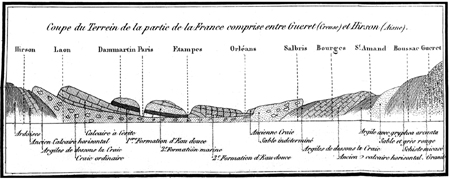› Le Bassin parisien, berceau de la géologie française

La coupe d'Omalius d'Halloy (1815)
>> agrandir le dessin
Le Bassin parisien, berceau de la géologie française
En 2014, l’Association des Géologues du Bassin de Paris célébrera son jubilé pour marquer d’une pierre blanche cinquante ans d’activité ininterrompue. À cette occasion, notre association se penchera sur son passé mais aussi sur l’histoire de l’étude géologique du Bassin parisien qui s’étend sur plus de cinq siècles puisque les premières observations remontent à Bernard Palissy (v. 1510-1590 ?). C’est pourquoi, il est prévu de faire coïncider avec le cinquantenaire de notre association la parution d’un livre de la série que publient les Presses des Mines sous le titre Histoire de la Découverte géologique de la France.
En raison de l’extrême centralisation administrative de notre pays, c’est à Paris que se regroupèrent, notamment auprès de l’Académie des sciences, certains savants qui, comme Réaumur (1683-1757) et Jean-Étienne Guettard (1715-1786) furent parmi les premiers à publier sur les roches et les fossiles de notre région.
Guettard fut bientôt investi du gigantesque projet d’Atlas minéralogique de la France auquel participa dans sa jeunesse un autre académicien célèbre, Antoine-Laurent de Lavoisier (1743-1794), qui fut le premier à concevoir la notion de cycle transgression-régression à l’occasion d’une étude des falaises de craie de Normandie (1789). C’est toutefois la publication, en 1811, du célèbre Essai sur la géographie minéralogique des environs de Paris de Georges Cuvier et Alexandre Brongniart, accompagné d’une Carte géognostique, qui constitue l’innovation majeure avec la description, au-dessus de la Craie, des principales strates constituant les terrains que l’on désignera désormais comme "tertiaires".
Quatre ans plus tard, un géologue belge, Jean-Baptiste d’Omalius d’Halloy (1783-1875), auquel la politique expansionniste de la France accorda jusqu’en 1814 la citoyenneté française, reconnut enfin la structure du Bassin de Paris.
La suite de cette histoire vous sera contée dans le volume actuellement en préparation, dont le titre vous est révélé ci-dessus en avant-première.
The Basin of Paris, cradle of French geology
In 2014, the Association will celebrate its fiftieth anniversary to mark a historic milestone for fifty years of continuous activity. In this occasion, our association will look upon its past as well as upon the history of the geological study of the Paris Basin which extends over more than five centuries, the first observations dating back to Bernard Palissy (circa 1510-1590). That is why it is planned that the publication of a book of the series that the Presses des Mines publish under the title History of the geological discovery of France would coincide with the fiftieth anniversary of our association.
As a result of the extreme administrative centralization of our country, Paris was the place where gathered, in particular around the Academy of Sciences, scholars like Réaumur (1683-1757) and Jean-Étienne Guettard (1715-1786) who were among the first to publish about rocks and fossils of our region.
Guettard was soon invested with the gigantic project of a Mineralogical Atlas of France, in which participated another famous academician in his youth, Antoine-Laurent de Lavoisier (1743-1794), who was the first scholar to conceive the notion of transgression-regression cycle as he was studying the chalk cliffs of Normandy (1789).
However, it is the publication, in 1811, of the famous Memoir on the Mineralogical Geography of the Environs of Paris by Georges Cuvier and Alexandre Brongniart, accompanied by a Geognostic Map which constitutes the major innovation, with the description of the main strata which lie above the chalk and will henceforth be called “tertiary” beds.
Four years later, a Belgian geologist, Jean-Baptiste d’Omalius d’Halloy (1783-1875), to whom the expansionist policy of France granted French citizenship until 1814, understood and described the structure of the Basin of Paris.
The continuation of this story will be told you in the volume in preparation, the title of which is revealed to you above.
